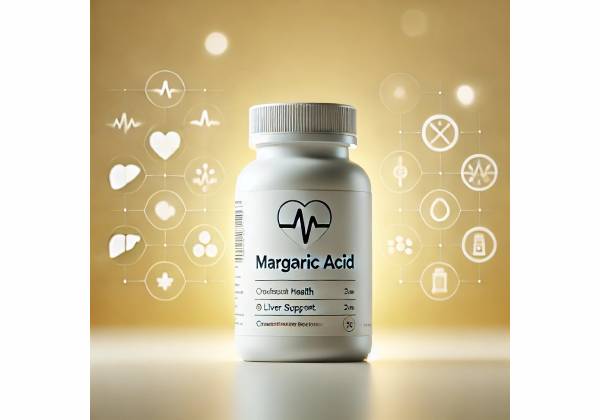
Margaric acid—also known as heptadecanoic acid or C17:0—is an odd-chain saturated fatty acid found in small amounts in ruminant fats, particularly dairy foods like butter, milk, and yogurt. Interest in C17:0 has grown because blood levels of odd-chain fats (C15:0 and C17:0) consistently track with dairy intake and, in many observational studies, with lower long-term risk of cardiometabolic diseases. Laboratory work also suggests that gut-derived propionate can contribute to our endogenous C17:0, which complicates how we interpret it as a biomarker. Still, for people curious about nutrition beyond macronutrient labels, margaric acid offers a useful lens on food quality, fermentation, and metabolic health.
In this guide, you’ll get a clear, people-first overview of what margaric acid is, what the research does—and does not—show, how to obtain it from foods, realistic dosage guidance anchored to everyday eating, and who should be cautious. You’ll also see a concise appraisal of the evidence quality so you can set the right expectations and make practical choices.
Essential Insights
- Higher circulating C17:0 often tracks with lower long-term risk of type 2 diabetes and cardiovascular disease, but this is association, not proof of benefit.
- Main food sources are dairy fats; typical foods provide ~10–400 mg C17:0 per 100 g depending on the product.
- Practical food-based exposure target: ~50–150 mg/day C17:0 from whole-food sources (e.g., fermented dairy, modest butter, some cheeses).
- Safety caveat: increasing saturated dairy fat can raise LDL-cholesterol in some people; monitor lipids and overall saturated fat intake.
- Avoid deliberate high intake if you have familial hypercholesterolemia, very high LDL-C, or a clinician has advised a low-saturated-fat diet.
Table of Contents
- What is margaric acid?
- Does it really benefit health?
- How to get it from diet
- Dosage and timing explained
- Side effects and who should avoid
- What the evidence says overall
What is margaric acid?
Margaric acid (heptadecanoic acid, C17:0) is an odd-chain saturated fatty acid with 17 carbon atoms. Unlike the more common even-chain saturated fats (such as palmitic acid, C16:0), odd-chain fats occur in smaller amounts in human diets and tissues. C17:0 is found principally in ruminant fats—dairy and to a lesser extent beef and lamb—because rumen microbes produce propionate and other short-chain substrates that can be incorporated into odd-chain fatty acids in the animal. Small amounts can also appear in certain fish and specialty fats.
Two features make margaric acid noteworthy:
- It is a dietary biomarker. Circulating levels of C17:0 often reflect dairy fat intake. In population studies, people who report or demonstrate higher dairy consumption tend to have higher blood levels of C15:0 and C17:0. This has made C17:0 a useful “objective” check on food frequency questionnaires and a tool to study long-term diet–disease relationships.
- It may be made endogenously. Humans can synthesize some C17:0 from propionate, a short-chain fatty acid produced by gut bacteria when they ferment dietary fiber. There are also biochemical pathways (for example, α-oxidation of even-chain fatty acids) that can yield odd-chain products. This means blood C17:0 is influenced by both what you eat and what your microbiome makes, not strictly by dairy intake alone.
Physical properties and food chemistry. Margaric acid is a waxy solid at room temperature with a melting point around 61 °C. In foods, it exists primarily as triglycerides within milk fat globules. Fermentation and feed influence dairy fatty acid profiles; for instance, cheeses from grass-fed or sheep/goat milk often show subtly different odd-chain patterns than those from conventional cow’s milk.
Why consumers care. Over the last decade, several cohort studies have reported that people with higher circulating C17:0 have lower risks of type 2 diabetes or cardiovascular disease over time. These findings sparked interest in whether C17:0 (and its “sibling” C15:0) might be protective—and whether choosing dairy types that naturally carry more odd-chain fats (or eating in ways that support fiber fermentation) could be beneficial. At the same time, controlled experiments haven’t confirmed direct causal benefits for C17:0, so cautious interpretation is essential.
Bottom line: Margaric acid is a distinctive marker of diet and metabolism at the intersection of dairy fat and gut fermentation. It’s a useful indicator and a small dietary constituent—not a miracle nutrient and not a replacement for balanced eating.
Does it really benefit health?
Short answer: Evidence from observational human studies links higher circulating C17:0 with lower long-term risk of type 2 diabetes and cardiovascular disease. However, interventional data specific to C17:0 are limited, and a well-controlled mouse study found that adding C17:0 to a high-fat diet did not improve insulin sensitivity or liver fat. The most defensible interpretation today is that C17:0 is a helpful biomarker of dietary pattern and possibly microbial metabolism, rather than a proven active agent that independently drives better outcomes.
What observational research shows. In pooled analyses following diverse populations across years, higher blood concentrations of odd-chain dairy biomarkers (C15:0 and C17:0) associate with:
- Lower incidence of type 2 diabetes. Multiple cohorts pooling thousands of participants found that people in the higher ranges of these biomarkers developed diabetes less often over time. This relationship persisted after accounting for age, adiposity, lifestyle factors, and other fatty acids.
- Lower risk of cardiovascular disease. An updated cohort plus meta-analysis reported that higher C17:0 (and C15:0) tracked with fewer cardiovascular events. These studies used blood or adipose biomarkers, which avoid some pitfalls of self-reported dairy intake.
Important caveats.
- Association ≠ causation. People with higher C17:0 often eat more fermented dairy (yogurt/cheese), cook less with refined carbohydrates, and live different lifestyles. Even with statistical adjustments, residual confounding is possible.
- Endogenous production blurs the picture. Fiber-fermenting gut bacteria produce propionate, a substrate for making odd-chain fats. A fiber-rich diet may raise C17:0 even without large dairy intake, so C17:0 can reflect diet quality more broadly.
- Mechanistic studies are mixed. In a controlled mouse study designed to test causality, long-term C17:0 supplementation did not reverse diet-induced hepatic steatosis or insulin resistance. In vitro work variably suggests immune-signaling effects, but these data are preliminary relative to human outcomes.
How to use this information wisely. Treat C17:0 as a signal of a dietary pattern that often includes fermented dairy and adequate fiber rather than as a stand-alone “active ingredient.” If your goal is metabolic health, improving the overall pattern—including unsweetened fermented dairy, higher fiber, minimally processed foods, regular activity, and weight management—remains the most reliable path.
Reasonable expectations. Choosing quality dairy in moderation can fit a heart-healthy diet for many people, and C17:0 helps researchers quantify that. But intentionally chasing C17:0 with large amounts of butter or cream can raise saturated fat intake and LDL-cholesterol in susceptible individuals without guaranteed benefit. If you want to experiment, do so within your personal lipid and calorie budgets, and re-check labs to see how your body responds.
How to get it from diet
Primary sources. The richest everyday sources of margaric acid are ruminant dairy fats. Typical approximate C17:0 contents (per 100 g food) reported in compositional analyses include:
- Butter: ~423 mg
- Whole-milk yogurt: ~31 mg
- Whole milk: ~19 mg
- 2% milk: ~10 mg
These values vary by animal species, feed, and season, but the pattern holds: concentrated dairy fat (butter, ghee) carries the most, while fluid milk and yogurt carry less. Full-fat cheeses contribute modest amounts per serving; sheep and goat cheeses can differ from cow’s milk cheeses because of fat composition and fermentation.
A practical, food-first plan. If your target is roughly 50–150 mg/day of C17:0 through normal foods, you can mix and match:
- 170 g (6 oz) whole-milk yogurt (~50 mg)
- 250 mL (1 cup) whole milk (~45–50 mg)
- 10–15 g butter (~40–65 mg)
- 30 g aged cheese (varies; assume ~10–30 mg depending on type)
You don’t need all of these in one day; choose based on preferences, calories, and saturated fat goals. If you prefer lower-fat dairy overall, a smaller pat of butter or a serving of yogurt can still get you into the lower end of the range.
Fiber matters. Because gut fermentation can boost endogenous odd-chain fat synthesis, prioritize soluble-rich fibers (oats, legumes, barley, root vegetables, inulin-containing foods). This improves your odds of favorable odd-chain status without relying exclusively on dairy fat. Practical ideas:
- Breakfast: overnight oats with unsweetened whole-milk yogurt and berries.
- Lunch: lentil salad with olive oil and lemon; small piece of cheese.
- Dinner: barley-mushroom pilaf; sautéed greens; optional 10 g butter used for flavoring.
Quality signals in dairy. Unsweetened fermented dairy (yogurt, kefir, aged cheeses) fits many cardiometabolic patterns better than sweetened dairy desserts. Fermentation can modestly shape fatty acid profiles and provides live cultures that support gut health. Choose minimally processed options without added sugars.
Non-dairy sources. Certain fish and specialty fats may contain trace odd-chain fats, but their contributions are usually minor compared to dairy. Plant oils are generally poor sources of C17:0.
Working within saturated fat budgets. Most dietary guidelines advise keeping saturated fat to a defined percentage of total calories. You can meet a 50–150 mg/day C17:0 exposure while staying within those limits by using small, flavorful portions (e.g., 10 g butter on vegetables) and emphasizing fermented over cream-heavy dairy. If you have hypercholesterolemia or you are on lipid-lowering therapy, talk to your clinician before raising dairy fat intake.
Tip: If you already enjoy cheese or yogurt, you likely consume some C17:0. Focus on overall dietary patterns—more fiber, fewer refined sugars—rather than micromanaging a single fatty acid.
Dosage and timing explained
There is no established “supplement dose” for margaric acid in humans. Most of what we know comes from:
- Food composition (how much C17:0 typical dairy servings provide), and
- Biomarker studies (how people’s blood levels of C17:0 relate to long-term health outcomes).
Because C17:0 occurs naturally in small amounts, a sensible food-based exposure target is ~50–150 mg/day. This is achievable with everyday foods while keeping calories and saturated fat in check. Examples that hit this range:
- Option A (lower-calorie): 170 g unsweetened yogurt (~50 mg) + a small 5 g pat of butter (~20 mg)
- Option B (moderate): 250 mL whole milk (~45–50 mg) + 15 g butter (~60 mg)
- Option C (balanced): 30 g aged cheese (~10–30 mg) + 170 g yogurt (~50 mg) + fiber-rich meals to support endogenous synthesis
Timing. There is no special timing for C17:0 intake. Fatty acid profiles in blood compartments change slowly:
- Plasma phospholipids can reflect recent weeks of intake.
- Erythrocyte membranes and adipose tissue reflect months of intake.
If you adjust your diet, expect 8–12 weeks before blood fatty acid biomarkers stabilize meaningfully. People monitoring C17:0 (or the ratio of odd- to even-chain fats) with their clinician should retest no sooner than every 2–3 months.
Supplement forms. Stand-alone C17:0 oils or capsules are uncommon, and controlled human trials are sparse. If you encounter over-the-counter products, treat them as experimental and discuss with a healthcare professional, particularly if you have lipid disorders. A more evidence-aligned approach is to optimize whole-food sources and fiber intake.
Interactions with other nutrients.
- C15:0 vs C17:0. These “sibling” odd-chain fats often rise together with dairy intake, but emerging data suggest they might not act identically. Some mechanistic work points to potential bioactivity for C15:0; C17:0’s direct effects are less convincing to date.
- Fermentable fiber. By feeding propionate-producing microbes, fiber can nudge odd-chain status upward without added saturated fat.
- Overall fat quality. Keep the broader picture in mind: mono- and polyunsaturated fats (from olive oil, nuts, fish) remain central to cardiometabolic health.
Monitoring response. If you decide to nudge C17:0 higher through diet:
- Set a modest target (e.g., +50 mg/day via yogurt or small butter portion).
- Hold steady for 8–12 weeks.
- Re-check labs (LDL-C, non-HDL-C, triglycerides; optional: fatty acid profile).
- Adjust based on personalized lipid response.
Who may need lower targets. Anyone with high LDL-C, familial hypercholesterolemia, or a clinical recommendation to restrict saturated fat should either avoid additional dairy fat or use fermented low-fat options to obtain minimal C17:0 while prioritizing cardioprotective dietary patterns.
Side effects and who should avoid
Tolerability. When obtained from normal foods, margaric acid is well tolerated. There is no recognized deficiency state, and it is not classified as an essential nutrient. Most side effects ascribed to “raising C17:0 intake” would actually reflect higher saturated fat intake from dairy fats rather than the molecule itself.
Potential issues to watch:
- LDL-cholesterol elevations. Some individuals experience rises in LDL-C when increasing butter, cream, or high-fat cheese. If you are experimenting with dairy fat to raise C17:0, monitor lipids and pivot to fermented, lower-fat options if LDL-C climbs.
- Calorie creep. Butter and cheese are energy dense. Without mindful portions, total calorie intake can rise quickly, counteracting metabolic goals.
- Gastrointestinal sensitivity. People with lactose intolerance may tolerate aged cheeses and yogurt (lower lactose) better than milk. Rarely, concentrated saturated-fat supplements can cause GI discomfort; if you try any, start low.
- Allergy considerations. Dairy protein allergies necessitate avoidance of dairy foods regardless of fatty acid profile.
Medication and condition interactions.
- Hyperlipidemia or cardiovascular disease. Follow your clinician’s advice on saturated fat; many patients will be advised to emphasize low-fat or fermented dairy and prioritize unsaturated fats.
- Familial hypercholesterolemia (FH). Avoid intentional increases in saturated dairy fat.
- Type 2 diabetes or fatty liver disease. Observational links between odd-chain fats and better outcomes are encouraging, but they are not a license to substantially raise saturated fat. Focus first on weight management, fiber, and overall diet quality; add small amounts of fermented dairy if compatible with your plan.
- Pregnancy and breastfeeding. Normal dietary intake is fine for most; there is no evidence base for C17:0 supplements in this group, so avoid concentrated products.
Safe upper limits. No specific upper limit exists for C17:0. In practice, keep within your saturated fat budget while meeting your protein, fiber, and micronutrient needs. If your LDL-C is well-controlled and your clinician approves, small portions of fermented dairy or modest butter used for flavor can fit most diets.
When to stop or seek help. If a dietary shift toward higher-fat dairy leads to rising LDL-C, new digestive symptoms, or weight gain, scale back and consult a professional. Remember: C17:0 is a marker, not a mandate.
What the evidence says overall
Synthesis in one page:
- Strengths of the case for C17:0. Across multiple cohorts spanning continents, higher blood levels of odd-chain fats—especially C17:0—are consistently associated with lower cardiometabolic risk. These studies relied on objective biomarkers rather than self-reports, strengthening their internal validity. The associations appear reasonably robust to adjustment for confounders.
- Why that doesn’t prove benefit. Biomarkers reflect dietary patterns and endogenous metabolism. People with higher C17:0 often eat differently (more fermented dairy, fewer refined carbohydrates), weigh less, exercise more, or have healthier gut microbiomes. Even sophisticated statistics cannot fully separate these influences. Moreover, the biological plausibility for C17:0 as a direct actor remains weaker than for other nutrients: controlled mouse work did not show reversal of fatty liver or insulin resistance with C17:0 supplementation, and head-to-head cell studies indicate more promising signals for C15:0 than for C17:0.
- What’s most likely true today. C17:0 is best treated as a read-out of a dietary and microbial ecosystem that tends to be healthier—one that includes unsweetened fermented dairy in moderation and adequate fermentable fiber. Pursuing that pattern is reasonable. Pursuing high-fat dairy purely to spike C17:0 is less compelling, especially if it worsens LDL-cholesterol or energy balance.
- Practical middle path. If you enjoy dairy, lean on yogurt, kefir, and aged cheeses; use small amounts of butter for flavor, and round out your diet with whole grains, legumes, vegetables, nuts, and seafood. This approach likely maintains a favorable odd-chain signature while honoring cardiometabolic fundamentals.
- Research gaps to watch. We need randomized trials that manipulate food-based odd-chain exposure within isocaloric, heart-healthy diets; long-term studies that parse effects of fermented vs non-fermented dairy; and mechanistic work clarifying how microbiome-derived propionate shapes human odd-chain status and risk.
Bottom line for readers. Margaric acid is a useful clue about diet quality—not a magic lever. Use it to nudge choices toward fermented dairy and fiber-rich foods while keeping saturated fat and calories in check. Let your lipid panel and long-term health markers be your compass.
References
- Biomarkers of dairy fat intake, incident cardiovascular disease, and all-cause mortality: A cohort study, systematic review, and meta-analysis 2021 (Systematic Review)
- Fatty acid biomarkers of dairy fat consumption and incidence of type 2 diabetes: A pooled analysis of prospective cohort studies 2018 (Systematic Review)
- Heptadecanoic Acid Is Not a Key Mediator in the Prevention of Diet-Induced Hepatic Steatosis and Insulin Resistance in Mice 2023 (RCT/Animal Mechanistic Study)
- Effect of Microbial Status on Hepatic Odd-Chain Fatty Acids Is Diet-Dependent 2021 (Mechanistic Study)
- Increased dietary intake of saturated fatty acid heptadecanoic acid (C17:0) associated with decreasing ferritin and alleviated metabolic syndrome in dolphins 2015 (Intervention; Food Composition Data)
Medical Disclaimer
This article is for educational purposes only and is not a substitute for personalized medical advice, diagnosis, or treatment. Nutrition and lipid responses vary widely. Always consult a qualified healthcare professional before making significant dietary changes, especially if you have high cholesterol, cardiovascular disease, diabetes, familial hypercholesterolemia, or are pregnant or breastfeeding.
If you found this helpful, consider sharing it with a friend or on Facebook or X (formerly Twitter), and follow us for more evidence-based guides. Your support helps us continue creating high-quality content. Thank you!










